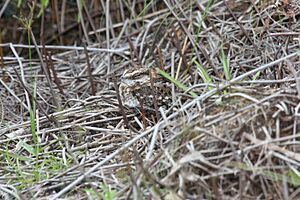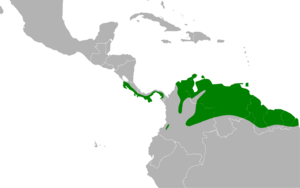White-tailed nightjar facts for kids
Quick facts for kids White-tailed nightjar |
|
|---|---|
 |
|
| Conservation status | |
| Scientific classification | |
| Genus: |
Hydropsalis
|
| Species: |
cayennensis
|
 |
|
The white-tailed nightjar (Hydropsalis cayennensis) is a cool bird that flies mostly at night. It belongs to a bird family called nightjars. You can find these birds in warm, tropical areas of Central and South America.
Contents
About the White-tailed Nightjar
Naming the Bird
The white-tailed nightjar was first officially described in 1789. A German scientist named Johann Friedrich Gmelin gave it its first scientific name. He put it in the Caprimulgus group, which included all nightjars back then.
Later, in 1832, another German scientist, Johann Georg Wagler, created a new group called Hydropsalis. The white-tailed nightjar and three other species now belong to this group. The name Hydropsalis comes from ancient Greek words meaning "water-" and "pair of scissors." The second part of its name, cayennensis, tells us it was first found near Cayenne in French Guiana.
Different Types of White-tailed Nightjars
Scientists recognize six different types, or subspecies, of the white-tailed nightjar. They are:
- H. c. albicauda (Lawrence, 1875) – Lives from Costa Rica to northern Colombia.
- H. c. aperta (Peters, JL, 1940) – Found in western Colombia and northern Ecuador.
- H. c. cayennensis (Gmelin, JF, 1789) – This is the original type, found from eastern Colombia through Venezuela and the Guianas to northern Brazil.
- H. c. insularis (Richmond, 1902) – Lives in northeastern Colombia, northern Venezuela, and nearby islands.
- H. c. leopetes (Jardine & Selby, 1830) – Found on the islands of Trinidad and Tobago.
- H. c. manati (Pinchon, 1963) – Lives on the island of Martinique in the Lesser Antilles.
What Does It Look Like?
The white-tailed nightjar is about 20 to 22.5 centimeters (8 to 9 inches) long. That's about the length of a standard ruler! Males usually weigh 33 to 40 grams, and females weigh 32 to 38 grams.
Male birds of the main type have grayish-brown backs. They have speckles and streaks of brown or blackish-brown. Their face has a white or light yellow stripe above the eye and a "moustache" mark. A wide, yellowish-brown band is around their neck.
Their wings are mostly grayish to blackish-brown with yellow-brown marks. When their wings are spread or folded, you can see a white band. Their tail looks a little forked. Most of the tail feathers are partly or completely white.
The male's chin and throat are white. Its chest is light yellow-brown with brown stripes and clear white spots. The belly and sides are white with a light yellow-brown tint.
Female birds of the main type are generally darker. They do not have white on their wings or tail. Their throat is light yellow-brown, their chest is brownish, and their belly is yellow-brown with brown stripes.
Other types of white-tailed nightjars have slight differences in color and size. For example, H. c. manati is darker and has less white in its tail.
What Does It Sound Like?
The white-tailed nightjar's call is a high, thin sound: "pt-cheeeeeeeee." The second note is a long, rising whistle that drops slightly at the end. Males sing this song from dusk until late at night during breeding season. They also make a scratchy "wheer" sound when flying. If you scare one from its resting spot, it might make a thin "tic-tic" sound.
Where Does It Live?
You can find the white-tailed nightjar in many places. These include the ABC Islands, Brazil, Colombia, Costa Rica, Ecuador, French Guiana, Guyana, Martinique, Panama, Suriname, Trinidad and Tobago, and Venezuela.
This bird likes open areas. It lives in places like savannas, pastures, grassy areas with bushes, and hillsides with scattered shrubs.
How It Lives
Feeding Habits
The white-tailed nightjar is a nocturnal bird, meaning it is active at night. It mainly hunts insects by flying out from the ground or a perch. It also hunts while flying low over open grasslands. We don't know all the details of its diet, but it eats insects. During the day, it rests on the ground.
Reproduction and Life Cycle
The breeding seasons for the white-tailed nightjar are not fully known. They seem to change depending on where the birds live. Male birds perform a special display where they clap their wings.
Females lay two eggs directly on the ground. Only the female bird sits on the eggs to keep them warm until they hatch. This is called incubation.
Conservation Status
The IUCN (International Union for Conservation of Nature) has listed the white-tailed nightjar as a species of "Least Concern." This means it is not currently in danger of disappearing. It lives in a very large area and has a big population. However, its population is thought to be slowly getting smaller.
There are no major threats to the species as a whole. But on the island of Martinique, there are some worries. The places where the birds live are being destroyed, and new animals brought to the island are hunting them.


